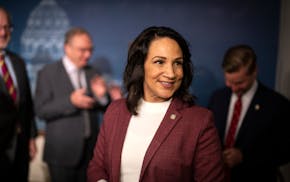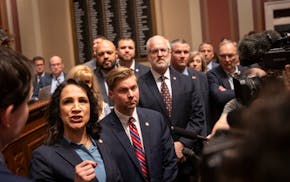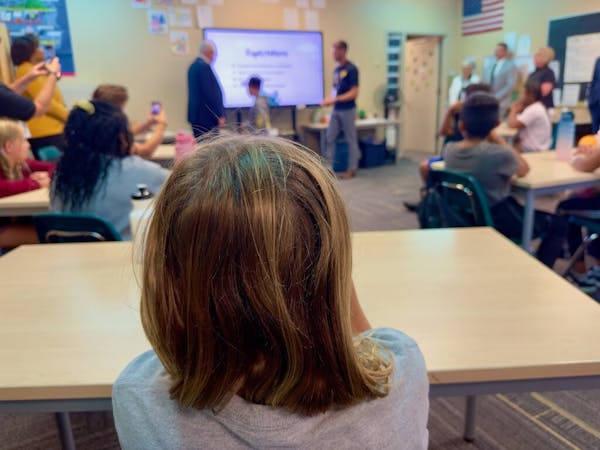Minnesota is in the midst of implementing sweeping changes to the way young children learn how to read. And a new national report lists the state as among the best poised to improve literacy, which has long declined across the country and fell further during the pandemic.
The National Council on Teacher Quality (NCTQ) gave the state its highest rating due in large part to new legislation that requires districts to train teachers and purchase classroom materials aligned with the so-called science of reading. Districts around the state are now training their teachers on that set of instructional practices, which leans heavily on giving children explicit instruction in how to dissect words to build their understanding of how language works.
"It's promising that the Legislature has put this into place," NCTQ President Heather Peske said. "In order for these efforts to be successful, it's important for educators to be supported."
But some education researchers and Minnesota school district administrators say the report skims the surface of what schools and districts must do in order to improve sagging reading scores. In Minnesota, about half of third graders could read at grade level, according to the most recent testing data. And 61% of fourth graders are proficient, according to national assessments NCTQ used in its report.
Katie Pekel, executive director of educational leadership at the University of Minnesota College of Education and Human Development, said it's tricky to rate education policy on a national level because of states' different approaches.
"They're taking a very centralized approach to something that is usually highly decentralized," she said of the report.
Pekel also said the report leans too heavily on policy without accounting for implementation.
Praise for new legislation
The report praises Minnesota for its requirements in teacher preparation programs — and oversight of them. In those programs, teacher must learn the five key components of literacy and how to teach struggling readers, particularly those with dyslexia and children learning English as a second language.
NCTQ also gave the state points identifying the curriculum districts should use and providing funding for those materials. The nonprofit also scored the state highly for requiring elementary teachers to be trained in a program that aligns with the science of reading.
But NCTQ also said Minnesota has a ways to go. Researchers suggest the state should require elementary teacher candidates to prove they're up-to-date on the latest science on reading. It also says Minnesota should report how many candidates pass a teacher prep program's elementary licensing assessments on their first attempt.
"We're really emphasizing that for these efforts to succeed, we have to ensure teachers have the knowledge and the training to do it well," Peske said.
The sweeping education bill DFL Gov. Tim Walz signed into law in 2023 included several provisions meant to ensure those trainings are consistent throughout the state. District leaders across the metro say those mandates reflect much of what they were already working toward but forces them to expedite it.
"I think the hurdle for districts is that the timeline and compliance pieces are difficult to accommodate," said Lisa Edwards, the Farmington school district's director of elementary learning.
Districts see some hurdles
Minnesota districts have until next September to train all of their elementary teachers and principals in the science of reading. Those trainings, including the popular Language Essentials for Teachers of Reading and Spelling (LETRS), typically cost up to $1,000 per license.
The state also is requiring districts to select from two literacy screening assessments and encouraging them to pick from a recently released list of approved curricula.
Farmington Superintendent Jason Berg says the district hasn't finalized just how much it will cost to train all its teachers and buy new material but estimates those costs at $130,000 to $280,000.
"Curriculum is expensive," Berg said.
If districts want to tap $30 million the Legislature set aside for classroom materials, they have to use the state's approved curriculum.
While Peske said the state should outright require districts to use those programs if it wants to improve literacy, Pekel said the carrot is preferable to the stick.
"I actually think it struck a pretty good balance there," Pekel said.
In the months since the reading bill became law, some districts also say they've faced challenges in getting all of their staff trained on-time. Farmington officials say they had to review their academic calendar to find pockets of time to dedicate to the new programs. In Osseo, Superintendent Kim Hiel and elementary curriculum coordinator Jamie Boylesay it's taking some teachers longer than expected to get through the training.
Still, they expect they'll meet the state's timeline.
"This is a really explicit, systematic and sequential approach to reading," Hiel said. "A lot of this comes down to making a mindset change — what were you doing before that you won't be doing anymore?"
A new approach to reading lessons
Carmy Mersereau, a second grade teacher at Fair Oaks Elementary in Brooklyn Park, already has been through LETRS training and incorporated its lessons into her work. In her 33 years working in the Osseo district school, she says new training approaches have come and gone, "kind of in a circle."
This time feels different, Mersereau said, because she can see how well her students focus when they work together. The methods she used before asked teachers to instill certain traits in fledgling readers, often by intensely drilling on vocabulary, that left some of her kids frustrated.
"Before it was like we told them, 'You have to be a better reader, you have to be better students,'" Mersereau said. "But we didn't tell them why."
Peske, the NCTQ president, said the nonprofit's report is meant to shed light on how states can ensure all of their teachers are armed with the most current training, whether they're new to the classroom or longtime educators.
"The bottom line is that teachers matter so much when it comes to students learning how to read," Peske said.

Want to share info with the Star Tribune? How to do it securely

'Safe recovery sites' would offer syringes, naloxone and more to people using drugs. The plan could be in peril.
New Minnesota GOP leaders seek peace with party's anti-establishment wing

Who is Republican Lisa Demuth, Minnesota's first House speaker of color?


